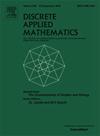Rainbow short linear forests in edge-colored complete graph
IF 1
3区 数学
Q3 MATHEMATICS, APPLIED
引用次数: 0
Abstract
An edge-colored graph is called rainbow if no two edges of have the same color. For a graph and a subgraph , the anti-Ramsey number is the maximum number of colors in an edge-coloring of such that contains no rainbow copy of . Recently, the anti-Ramsey problem for disjoint union of graphs received much attention. In particular, several researchers focused on the problem for graphs consisting of small components. In this paper, we continue the work in this direction. We refine the bound and obtain the precise value of for all . Additionally, we determine the value of for any integers and .
边色完整图中的彩虹短线性森林
如果一个边着色的图 G 没有两条边的颜色相同,则称其为彩虹图。对于图 G 和子图 H⊆G,反拉姆齐数 AR(G,H) 是指在 G 的边染色中,G 不包含 H 的彩虹副本的最大颜色数。特别是,一些研究人员重点研究了由小分量组成的图的反拉姆齐问题。在本文中,我们将继续这一方向的研究。我们完善了边界,并得到了所有 n≥2t+3 时 AR(Kn,P3∪tP2) 的精确值。此外,我们还确定了任意整数 t≥1 和 n≥2t+7 时的 AR(Kn,2P3∪tP2) 值。
本文章由计算机程序翻译,如有差异,请以英文原文为准。
求助全文
约1分钟内获得全文
求助全文
来源期刊

Discrete Applied Mathematics
数学-应用数学
CiteScore
2.30
自引率
9.10%
发文量
422
审稿时长
4.5 months
期刊介绍:
The aim of Discrete Applied Mathematics is to bring together research papers in different areas of algorithmic and applicable discrete mathematics as well as applications of combinatorial mathematics to informatics and various areas of science and technology. Contributions presented to the journal can be research papers, short notes, surveys, and possibly research problems. The "Communications" section will be devoted to the fastest possible publication of recent research results that are checked and recommended for publication by a member of the Editorial Board. The journal will also publish a limited number of book announcements as well as proceedings of conferences. These proceedings will be fully refereed and adhere to the normal standards of the journal.
Potential authors are advised to view the journal and the open calls-for-papers of special issues before submitting their manuscripts. Only high-quality, original work that is within the scope of the journal or the targeted special issue will be considered.
 求助内容:
求助内容: 应助结果提醒方式:
应助结果提醒方式:


